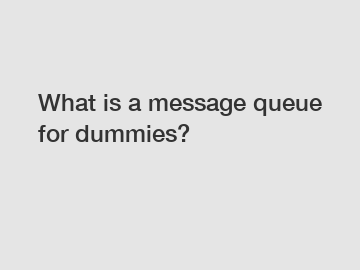What is a message queue for dummies?
What is a message queue for dummies?
A message queue is a key component in modern software architecture that allows different parts of a system to communicate with each other asynchronously. It is a powerful tool that helps ensure reliable and efficient data processing, making it an essential concept for every software developer, regardless of their level of expertise.
The term "message queue" may sound intimidating, but its purpose is actually quite straightforward. At its core, a message queue acts as a buffer that stores and forwards messages between components of a system. It works on a simple principle: when a sender wants to communicate with a receiver, it writes a message to the queue. The receiver then retrieves and processes that message when it is ready, ensuring that the communication is decoupled and asynchronous.

The concept of a message queue originates from the need to decouple different components in a distributed system. In traditional software architectures, components were tightly coupled, meaning one component would directly invoke another component's method or function. However, this tight coupling can lead to issues when components are not available or experience heavy workloads.
To overcome these challenges, the message queue was introduced as a way to separate the sending and receiving components. By introducing an intermediate buffer, the sender can write messages to the queue without worrying about when or how the receiver will process them. This introduces a level of flexibility and scalability to the system, as the components can operate independently without being reliant on each other's availability.
The significance of a message queue lies in its ability to ensure reliable and efficient data processing within a system. It helps alleviate the pressure on components during peak times by allowing them to process messages at their own pace. Moreover, it enables fault tolerance, as messages can be stored even if a component fails temporarily. Once the component is back online, it can resume reading messages from the queue, ensuring that no data is lost.
Furthermore, message queues have a significant impact on system scalability. With the ability to add multiple instances of components reading from the same message queue, a system can handle an increased load effortlessly. This scalability allows businesses to grow without disrupting the existing infrastructure, making message queues a valuable asset for both startups and large enterprises.
In conclusion, a message queue is a fundamental concept in modern software architecture that enables asynchronous and decoupled communication between different components. Its role in ensuring reliable and efficient data processing, fault tolerance, and system scalability cannot be understated. Understanding and leveraging the power of message queues is crucial for any software developer looking to build robust and scalable systems.
Want more information on aws slack channel, Event Stream System Blogs, Event Stream System Blogs? Feel free to contact us.
233
0
0

Comments
All Comments (0)